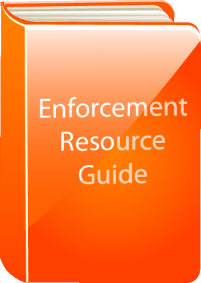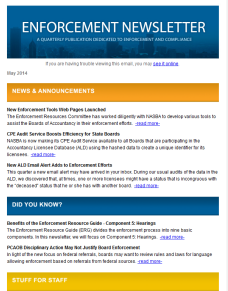Enforcement NewsletterMay 2014The Enforcement Resource Guide (ERG) divides the enforcement process into nine basic components. In this newsletter, we will focus on Component 5: Hearings. The hearing process varies among jurisdictions, based on each board’s administrative procedures. However, there are some consistent procedures among the boards, such as the need to provide notice before a formal hearing for disciplinary action can take place. The formalities of the notice are dictated by state law, but it must be deemed “reasonably calculated” to provide the licensee with information regarding the nature of the alleged charges, the time/date of the hearing, and the licensee’s rights at the hearing.
Some boards are required to deliberate on the record, meaning that the deliberation must be held in front of the parties and perhaps in public session of the board. Other states allow the deliberation to occur in closed session. When a decision is reached, the final order is entered. Hearings are typically transcribed by a court reporter should either party elect to appeal the final decision. If you have any information or samples you would like included in the Guide, please forward them to Stacey Grooms at [email protected]. The Enforcement Resource Guide is available to current executive directors and members of boards of accountancy through a password protected section of NASBA.org. Any questions regarding the guide can be directed to Stacey Grooms at [email protected]. |
Full Newsletter |
- MEMBER CENTER
- EXAMS
- LICENSURE
- EDUCATION

 If the licensee chooses to not attend the hearing, the hearing is held in the licensee’s absence and he/she is bound by its final decision. The hearing may be conducted with either a hearing officer, an Administrative Law Judge, or the board acting as trier of fact. Evidence may be submitted during the hearing, such as witness testimony and the submission of documents relevant to the case.
If the licensee chooses to not attend the hearing, the hearing is held in the licensee’s absence and he/she is bound by its final decision. The hearing may be conducted with either a hearing officer, an Administrative Law Judge, or the board acting as trier of fact. Evidence may be submitted during the hearing, such as witness testimony and the submission of documents relevant to the case.